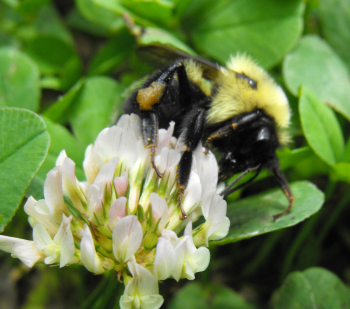
Introduction to nitrogen-fixing
Everett commented on my mention of
planting clover to
say:

You
probably already know this, but just in case... Don't forget the
inoculent (tried spelling it three different ways. I'm sure it's wrong
but you get the point) for your clover. I tried some without it and
they were patchy at best. Then I tried WITH inoculation and had a nice
thick patch of clover. I guess it really makes a difference.
I don't know why inoculant is so hard to spell, but I struggle with it too and seem to have to look it up every few weeks. Anyway, back to the point....
If you're not a gardener, you may not realize that nitrogen is usually the limiting ingredient in many plants' growth, and is thus one of the big three components of chemical fertilizers. Organic gardeners often add nitrogen to the soil with compost or manure, but others take advantage of nitrogen-fixing bacteria to turn the copious nitrogen in the atmosphere into nitrogen their plants can use. This week's lunchtime series will explore how this symbiosis can be worked to your advantage in the garden.
Check out our chick waterer, perfect for day-old
chickens!
| This post is part of our Nitrogen Fixing lunchtime series.
Read all of the entries: |
Want more in-depth information? Browse through our books.
Or explore more posts by date or by subject.
About us: Anna Hess and Mark Hamilton spent over a decade living self-sufficiently in the mountains of Virginia before moving north to start over from scratch in the foothills of Ohio. They've experimented with permaculture, no-till gardening, trailersteading, home-based microbusinesses and much more, writing about their adventures in both blogs and books.
Want to be notified when new comments are posted on this page? Click on the RSS button after you add a comment to subscribe to the comment feed, or simply check the box beside "email replies to me" while writing your comment.
RSS
comment 1
One point about innoculants. These little beasties live in the soil, and innoculation is a waste of money if clover or beans have grown in the soil recently.
Comment by
Errol
— Mon Feb 8 16:34:56 2010
- Remove comment
comment 2
Hey! No skipping ahead! That's Thursday's post.  (You're completely right.)
(You're completely right.)
 (You're completely right.)
(You're completely right.)
Comment by
anna
— Mon Feb 8 17:32:17 2010
- Remove comment
Add a comment
